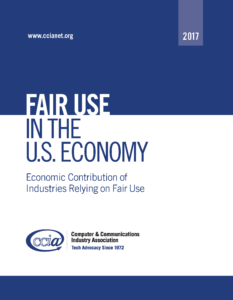 Computer & Communications Industry Association, Fair Use in the U.S. Economy: Economic Contribution of Industries Relying on Fair Use (CCIA: 2017), available online at ccianet.org.
Computer & Communications Industry Association, Fair Use in the U.S. Economy: Economic Contribution of Industries Relying on Fair Use (CCIA: 2017), available online at ccianet.org.
Executive Summary: In 2007, CCIA released a report prepared by Capital Trade, Inc. that was the first comprehensive study quantifying the U.S. economic contribution of industries relying on fair use and related legal provisions. The current report is the third update of the size and performance of the fair use economy. This study finds that in 2014, value added by fair use industries was 16 percent of the U.S. economy, employing 1 in 8 U.S. workers, and contributing $2.8 trillion to U.S. GDP. Meanwhile, the combined value added by industries that are the most reliant on fair use and other limitations and exceptions to copyright protections has more than tripled in size over 2002. From 2012 to 2014, the real output of these primary core industries accounted for 6.7 percent of real GDP growth, six times their current weight in the U.S. economy.
The U.S. has developed one of the strongest and most innovation-friendly copyright systems in the world — including both strong enforcement mechanisms to prevent infringement, and strong limitations and exceptions to copyright protection that have become a major catalyst of U.S. economic growth and jobs. Specific exceptions to copyright protection under U.S. law, classified here under the broad heading of “fair use,” are vital to many industries and stimulate growth across the economy. Companies benefiting from fair use generate substantial revenue, employ millions of workers, and represent one-sixth of total U.S. GDP.
The beneficiaries of fair use encompass a broad range of companies, particularly as more U.S. businesses rely on activities that involve the Internet to grow and reach their customers. The ubiquity of the Internet and Internet-enabled services means that the economic growth fostered by fair use is widespread and generates significant consumer benefits.
Examples of these industries include:
- manufacturers of consumer devices that allow individual copying and recording;
- educational institutions;
- software developers; and
- Internet search and web hosting providers.
These industries and others that depend upon fair use and related limitations and exceptions are referred to here as “fair use industries.” As summarized in the following report, core activities to the modern economy rely on fair use in situations that are integral to many industries. Copyright law has established, for example, that fair use permits the main service provided by search engines, that software development depends on making temporary copies to facilitate the programming of interoperability, and that consumers can make copies of television and radio programming for personal use.
Fair use industries have grown dramatically within the past 20 years, and their growth has had a profound impact on the U.S. economy, while opening up new opportunities for creators, see Boxes 4-6, and enabling appropriate protection of creative works.
This report contains detailed data organized by industry and summarizes economic activity and growth in five areas:
Revenue – The revenues generated by fair use industries expanded by $1.0 trillion, or 5.2 percent annually, from 2010 to 2014, reaching $5.6 trillion in 2014. In percentage terms, the most significant growth over this four-year period occurred in Internet publishing and broadcasting and web search portals, electronic shopping, and other financial investment activity. Electronic auctions and Internet service provider revenues also grew sharply.
Value Added – In 2014, value added by fair use industries was $2.8 trillion, approximately 16 percent of total U.S. current dollar GDP. Value added equals a firm’s total output minus its purchases of intermediate inputs and is the best measurement of an industry’s economic contribution to national GDP.
Fair use industries also grew at a faster pace than the overall economy. The core fair use industries account for approximately 10 percent of the U.S. economy. However, the core of the core — other information services (including Internet publishing and broadcasting and web search portals); Internet service providers; and data processing, hosting, and related services combined – contributed 6.7 percent of GDP growth from 2012 to 2014, far beyond their weight in the overall economy.
Employment – Employment in industries benefiting from fair use and related limitations and exceptions reached 18 million workers by 2014, adding one million workers from 2010 to 2014. About one out of every eight workers in the United States is employed in an industry that benefits from these protections.
Further illustrating the rapid growth of fair use industries, total payrolls expanded rapidly, rising from $1.20 trillion in 2010 to $1.45 trillion during 2014, an increase of 20 percent.
Productivity – Productivity, the amount of goods and services that can be produced with a given number of inputs, is the foundation for rising living standards. From 2010 to 2014, the labor productivity of U.S. fair use industries increased by 3.2 percent annually to approximately $155,000 per worker. These returns benefit both labor and capital, demonstrating why employees and investors continue to be attracted to these industries.
Exports – Exports of goods and services related to fair use industries increased by 21 percent from $304 billion in 2010 to $368 billion in 2014 driven by increases in service-sector exports. The fair use economy has become a defining aspect of the U.S. trade portfolio. The U.S. economy benefits from a substantial trade surplus attributable to fair use services industries.
In sum, fair use industries have expanded sharply since the Great Recession, driven primarily by the industries that rely most on fair use and other limitations and exceptions to copyright.




